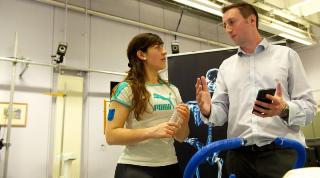May 21 2015
A wearable device being developed by the University of Strathclyde will provide real-time data analysis of fluid loss during exercise to enhance the performance of fitness enthusiasts and elite athletes.
 Dr. Stephen Milne demonstrates the device being used in a lab at the University of Strathclyde with Biomedical Engineering research associate Alejandra Aranceta Garza. Credit: Graeme Fleming
Dr. Stephen Milne demonstrates the device being used in a lab at the University of Strathclyde with Biomedical Engineering research associate Alejandra Aranceta Garza. Credit: Graeme Fleming
The innovative transdermal sensor is a small device that attaches to the body to analyse electrolytes in sweat, with bluetooth technology used to send the data back to a smartphone - allowing the user to rehydrate properly and maintain optimum performance.
With heart monitors, pace-calculators and GPS-enabled watches used widely to support a healthy lifestyle, and in elite sporting disciplines, academics at the University believe that hydration monitoring could be the latest addition to the market.
Dr Stephen Milne, of Strathclyde's Department of Biomedical Engineering, has been working on the technology and following successful trials in Qatar and UK, is keen to explore the commercialisation of the product.
He said: "Whether you're a serious athlete or someone who likes to keep fit, it's important to make sure you get the right amount of fluid before, during and after exercising. The sensor we have developed analyses the sweat produced during activity and provides feedback immediately to a smartphone or computer.
"On an individual level this would allow people to rehydrate during and after exercise. When it comes to team sports, fitness coaches would be able to monitor the data during matches and ensure athletes get what they need to maintain their performance.
"The sensor is small and wearing it on the skin does not cause any discomfort. During exercise the user would barely be aware of it, allowing them to focus on the activity without distraction."
While there are guidelines in place that help people understand how much they should drink, there is a demand for personalised information that will enhance overall performance and tailored hydration programmes.
Water regulates body temperature, lubricates joints and helps transport nutrients for energy and health. Inadequate hydration causes the body to under-perform and can lead to fatigue, muscle cramps, dizziness or more serious symptoms.
The sensors have been developed in the Medical Diagnostics Research Group at the University led by Professor Patricia Connolly. She added: "Stephen has been able to take our work in medical sensors and transdermal sensing from the healthcare applications into the field of sport.
"The stringent application of medical device standards to our laboratory research means that these sensors will be qualified at the highest level for human use and translatable between sports science and medicine.
"This is growing our portfolio of devices for use in home patient monitoring which can be coupled with telehealth systems and smartphones to deliver improved monitoring of patients. This system and our other diagnostics sensors are being supported for commercialisation through a University spin out company, Ohmedics Ltd."
The institute of sport is the high performance arm of sportscotland, where teams of experts in disciplines such as Physiotherapy, Performance Nutrition, Psychology, Skill Acquisition, Exercise Physiology and Performance Lifestyle work together, and with targeted help from external partners, provide high performance expertise to Scotland's top athletes.
sportscotland institute of sport's Innovation and Special Projects team and Strathclyde University are currently exploring how high performance sport applications of real time technologies can provide new advantages.
Dr Malcolm Fairweather, Head of Science and Innovation at sportscotland, said: "In high performance sport the ability to understand and then optimise an athlete's performance can mean the difference between winning medals or, going home empty handed."
Dr Marek Anestik, Senior Exercise Physiologist, added: "The ability to add wearable technology to the sophisticated feedback systems that we currently use to monitor and tune the performance of the athletes, could give Scotland a further competitive advantage".